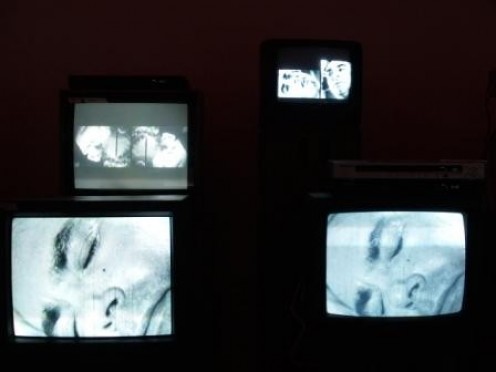Douglas Gordon: Blood, Sweat, Tears
4 Jun – 27 Sep 2009

Gordon’s work was part of the invasion of moving images into galleries and museums, which transformed the white cube of gallery space into a black box in the 1990s. However, Gordon’s use of the moving image has never been driven by technology, but rather by his interest in perception, which he considers his central theme. He often examines the issues of memory and identity by manipulating images through slow motion, splicing, mirroring, and doubling. These methods not only refer to the efforts of contemporary neuroscience, but also bring to mind the work of the most significant Czech scientist of the 19th century, Jan Evangelista Purkinje, who paved the way to the rise of moving images through his studies of apparent movement and other subjective phenomena. In addition to film and video, Gordon uses other media, including audio and text installations or photographs. He frequently links questions of perception and interpretation with moral principles, demonstrating how concepts like truth and falsehood or good and evil are deeply anchored in our perception of time and space.
Gordon’s 24 Hours Psycho (1993) is an important example in this respect. It is a reworking of Hitchcock’s film classic that is both simple and complex. By slowing down the movie projection almost to a halt, Gordon takes the narrative drive away from the movie to reveal stories that were hidden on a subliminal level and that add new dimension to the original narrative. Hitchcock’s masterpiece is thus deconstructed, while new viewings and readings are made possible. Gordon achieved this paradoxical feat by foregrounding the technical and physiological basis of cinema – the fact that our brain transforms a stream of still images into an apparent or virtual moving image.
Like 24 Hour Psycho (1993), Gordon's new version, 24 Hour Psycho Back and Forth and to and Fro (2008), presented in Europe for the first time, slows down the projection of Hitchcock’s classic film to a duration of 24 hours. This forces the viewer to relate the projected scenes to recollections of the original work and the time span of the film to real time. In addition, the artist uses the reverse-projection technique to double the narrative as if reflected in a mirror, contradicting the arrow of time.
Feature Film (1999) draws attention to the significance of film score, using the example of Vertigo by Alfred Hitchcock (1958). The film’s soundtrack is complemented by the artist’s video of conductor James Conleon, as he directs the Paris Opera Orchestra’s performance of Bernard’s Hermann’s original score.
Play Dead; Real Time (2003) juxtaposes motion with immobility as a symptom of death. The panning camera captures a trained elephant that plays dead and stands up on command within the confines of a white gallery space.
10ms-1 (1994) explores the theme of memory and body motion by appropriating vintage medical footage of a soldier from World War I who repeatedly attempts to stand up, and fails. The title represents the equation that expresses the rate of acceleration of a falling human body.
The most extensive installation in the exhibition is Pretty Much Every Film and Video Work From About 1992 Until Now, to Be Seen on Monitors, Some With Headphones, Others Run Silently and All Simultaneously. As the title indicates, the installation presents a concise retrospective of Gordon’s film and video work for the last 17 years, highlighting the artist’s major themes and formal methods.
30 Seconds Text (1996) contains a report by a French doctor written in the first person. It describes an experiment conducted on the head of a criminal decapitated by guillotine. The text is illuminated for 30 seconds, which, according to the doctor, is the amount of time the human brain can continue responding after decapitation.
The exhibition also includes the artist’s numerous text installations. The most complex, Zidane, Portrait of the 21st Century (2006), a documentary feature about the legendary football player, was created in collaboration with Phillipe Parreno and presented at the Cannes Film Festival. For the duration of 90 minutes of the match between Real Madrid and Villarreal, 17 cameras focused on one of the best football players in recent history, Zinedane Zidane, and captured his gestures, emotions, and movements. The film will be shown at the OKO movie theatre in conjunction with the exhibition.
Douglas Gordon has had more than 100 solo exhibitions on almost all continents and has received many prestigious international prizes, including: the Turner Prize (1996); the Venice Biennale Prize (1997); the Hugo Boss Prize (1998); and the Roswitha Haftmann Prize (2008). In addition to shows in New York’s MOMA (2006) and the Guggenheim Museum in Berlin (2005), there were exhibitions of his work at the Scottish National Gallery in Edinburgh and the Kunstmuseum Wolfsburg (2007).











